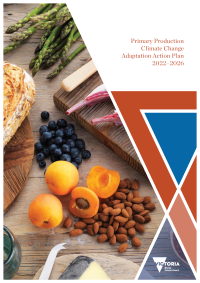The Primary Production Climate Change Adaptation Action Plan is one of 7 plans prepared by the Victorian Government for 7 statewide systems. The plans will help ensure Victoria’s climate resilience, now and into the future.
The challenge
Victoria’s primary industries are major export and wealth generators. They employ more than 190,000 people with over 80% of them in regional Victoria. The Primary Production system includes agriculture, plantation forestry, productive fisheries and the infrastructure, workforce and communities supporting them. It covers the full value chain: key inputs, growth and harvest, production and processing – everything that gets products to market.
As a result of climate change, Victoria is likely to become hotter and drier and experience increasingly frequent and extreme events such as heatwaves, bushfires and droughts. The availability of freshwater is likely to become more critical. These impacts are expected to affect access to key inputs, services and markets and lead to shifts in growing conditions and seasons. They could also increase the risk of negative impacts on worker health and animal welfare, increase pest and disease outbreaks, and reduce the availability of finance and insurance.
Adapting to climate change will also create opportunities. Bringing new products to market, generating efficiencies and diversifying production, land use and income streams will support business continuity and growth. By 2040, our primary industries need to be moving toward long-term transitions – continuing to respond to the changing climate and showing strong adaptive capacity.
Work already underway
- Implementing policies and strategies (such as Victoria’s Agriculture Strategy) that support thriving primary industries to better manage climate risks and opportunities.
- Collaborating with commercial fishers to improve reef kelp and algal habitats and food sources for fish.
- Supporting sustainable land management and farm planning services for irrigation and dryland regions.
- Investing in new technology such as solar photovoltaics and improved irrigation systems to increase water and energy efficiency, reduce costs and build climate resilience.
- Developing and delivering information and tools with farmers including seasonal forecasts and soil moisture and land-health monitoring for informed decision making.
- Providing agriculture extension services including resources and staff support and advice for regional and industry adaptation.
- Testing and demonstrating new technologies for farmers to showcase options to become more climate-resilient, increase productivity, improve livestock welfare and reduce emissions.
- Investing in native fish hatcheries, fish stocking programs, fisheries monitoring, and facilitating new aquaculture industries.
- Investing in the establishment of new plantations to support the long-term sustainability of Victoria’s timber harvesting industry.
Key priorities ahead
The next 5 years (2022–2026) will be focused on building the climate resilience of value chains, facilitating research and innovation, and supporting primary industries to build further on their climate change adaptation information, skills and capacity.
- Exploring ways to reduce climate change risks to key inputs and supports to the primary industries, such as water, energy, telecommunications, credit and insurance.
- Collaborating with health and community services to assess climate change-related health risks to primary industries workers and communities, and food safety issues for consumers.
- Investing in cross-disciplinary research, monitoring, trials, modelling and decision-ready information to improve understanding of climate change impacts and adaptation options for primary industries.
- Researching common issues, adaptation options and co-benefits for the interconnected Primary Production, Water Cycle and Natural Environment systems.
- Working with primary industries, both regionally and industry-wide, to support outreach and professional development to strengthen their adaptation skills and capacity. This includes efforts to support improved efficiencies and productivity, new technology and income diversification.
- Strengthening our knowledge of how emergency responses and recovery funds can support primary industries’ climate resilience.
Case study: A changing climate opens market opportunities for Victorian primary producers
Shifts in water availability and temperatures on land, and changing currents, chemistry and temperatures in our marine environment, will alter which fish are grown where and which species we harvest in our oceans. These changes may allow the targeting of new productive fish species in Victoria’s marine waters and create conditions for new aquaculture markets to develop, offering new opportunities to meet the demand for alternative proteins.
Victorian farmers in the Wimmera and Southern Mallee region are thinking of ways to stay productive and sustainable while facing the challenges of extreme events and less rainfall. International and domestic markets are boosting opportunities for Australian pulses – such as lentils, faba beans and chickpeas – driven by rising demand for plant-based proteins and growing awareness of health and wellbeing, animal welfare and environmental concerns. In Horsham, recent investments in the manufacture of plant-based protein will provide a potential new high-value avenue for pulses, which are sold as bulk commodities and routinely grown for disease control and soil quality improvement.
The Grains Research and Development Corporation and Agriculture Victoria is exploring innovative technologies and tools at the Horsham Grains Innovation Park to ensure research outputs are quickly adopted, helping plant breeders increase yields in different regions and adapt to the changing climate.
Further information
 | The Primary Production Climate Change Adaptation Action Plan will be delivered over the next 5 years (2022–2026), then updated every 5 years on the path to 2050. Read the full Adaptation Action Plan for the Primary Production system |
Page last updated: 15/02/22